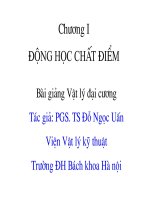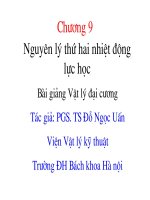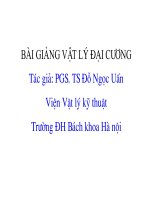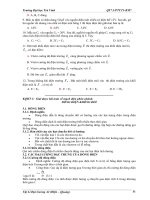FULL SLIDE Bài giảng Vật lí đại cương 2 Giáo trình tiếng anh
Bạn đang xem bản rút gọn của tài liệu. Xem và tải ngay bản đầy đủ của tài liệu tại đây (24.28 MB, 354 trang )
PHYSICS 1: MECHANICS AND THERMODYNAMICS
PHYSICS 2: ELECTRICITY, MAGNETISM, OPTICS,
AND MODERN PHYSICS
PART 4
Electricity and Magnetism
Chapter 1: Electric Fields
Chapter 2: Gauss’s Law
Chapter 3: Electric Potential
Chapter 4: Capacitance and Dielectrics
Chapter 5: Current and Resistance
Chapter 6: Direct-Current Circuits
Chapter 7: Magnetic Fields
Chapter 8: Sources of the Magnetic Field
Chapter 9: Faraday’s Law
CHAPTER 1
ELECTRIC FIELDS
1.1
1.2
1.3
1.4
1.5
1.6
1.7
Properties of Electric Charges
Charging Objects by Induction
Coulomb’s Law
Analysis Model: Particle in a
Field (Electric)
Electric Field of a Continuous
Charge Distribution
Electric Field Lines (study in
chapter 2)
Motion of a Charged Particle
in a Uniform Electric Field
(3)
CHAPTER 1 - ELECTRIC FIELDS
1.1 Properties of Electric Charges
Two types of charges: positive and negative
Charge interaction:
Charge of the same
sign repel one
another.
Charges with
opposite signs
attract one another.
Electric charge is
always conserved in
an isolated system.
CHAPTER 1 - ELECTRIC FIELDS
1.1 Properties of Electric Charges
Electric charge always occurs as integral multiples of a
fundamental amount of charge 𝑒 (quantized):
𝑞 = ±𝑁𝑒
Neutron: 𝑞𝑛 = 0, Proton: 𝑞𝑝 = 𝑒, Electron: 𝑞𝑒 = −𝑒
Positive ion: 𝑞+ = 𝑁𝑒, Negative ion: 𝑞− = −𝑁𝑒
CHAPTER 1 - ELECTRIC FIELDS
1.1 Properties of Electric Charges
Three objects are brought close to each other, two at a time.
When objects A and B are brought together, they repel. When
objects B and C are brought together, they also repel. Which of
the following are true?
(a) Objects A and C possess charges of the same sign.
(b) Objects A and C possess charges of opposite sign.
(c) All three objects possess charges of the same sign.
(d) One object is neutral.
(e) Additional experiments must be performed to determine the
signs of the charges.
CHAPTER 1 - ELECTRIC FIELDS
1.2 Charging Objects by Induction
Electrical conductors are materials in which some of the
electrons are free electrons that are not bound to atoms and
can move relatively freely through the material. Ex.: copper,
aluminum, silver,…
Electrical insulators are materials in which all electrons are
bound to atoms and cannot move freely through the
material. Ex.: glass, rubber, dry wood,…
Semiconductors are a third class of materials, and their
electrical properties are somewhere between those of
insulators and those of conductors. Ex.: Silicon,
germanium,…
CHAPTER 1 - ELECTRIC FIELDS
1.2 Charging Objects by Induction
CHAPTER 1 - ELECTRIC FIELDS
1.2 Charging Objects by Induction
Three objects are brought close to one another, two at a time.
When objects A and B are brought together, they attract. When
objects B and C are brought together, they repel. Which of the
following are necessarily true?
(a) Objects A and C possess charges of the same sign.
(b) Objects A and C possess charges of opposite sign.
(c) All three objects possess charges of the same sign.
(d) One object is neutral.
(e) Additional experiments must be performed to determine
information about the charges on the objects.
1.3 Coulomb’s Law
CHAPTER 1 - ELECTRIC FIELDS
Electric force between two stationary point charges
(called electrostatic force or Coulomb force):
𝒒𝟏 𝒒𝟐
𝑭 𝒆 = 𝒌𝒆
𝒓𝟐
Coulomb constance:
1
𝑘𝑒 =
= 8.987 × 109 N. m2 /C 2
4𝜋𝜀0
where 𝜀0 is permittivity of free space
𝜀0 = 8.854 × 10−12 C 2 /m2 N
𝑞1 , 𝑞2 : magnitude of point charges
𝑟: distance between two charges
Point charge: charged particle of zero size
1.3 Coulomb’s Law
CHAPTER 1 - ELECTRIC FIELDS
Example 1.1
The electron and proton of a hydrogen atom are separated (on the average)
by a distance of approximately 5.3 × 10-11 m. Find the magnitudes of the
electric force and the gravitational force between the two particles.
1.3 Coulomb’s Law
Vector form of Coulomb’s law:
The electric force exerted by a charge
𝒒𝟏 on a second charge 𝒒𝟐
𝒒𝟏 𝒒𝟐
𝑭𝟏𝟐 = 𝒌𝒆 𝟐 𝒓𝟏𝟐
𝒓
𝒓𝟏𝟐 is a unit vector directed from 𝑞1
toward 𝑞2
The force exerted by 𝑞2 on 𝑞1
𝐹21 = −𝐹12
When more than two charges are
present, for example, if four charges
are present, the resultant force
exerted by particles 2, 3, and 4 on
particle 1 is
𝑭𝟏 = 𝑭𝟐𝟏 + 𝑭𝟑𝟏 + 𝑭𝟒𝟏
CHAPTER 1 - ELECTRIC FIELDS
CHAPTER 1 - ELECTRIC FIELDS
1.3 Coulomb’s Law
The Superposition Principle
1.3 Coulomb’s Law
CHAPTER 1 - ELECTRIC FIELDS
Object A has a charge of +2 µC, and object B has a charge of
+6 µC. Which statement is true about the electric forces on
the objects?
(a) 𝐹𝐴𝐵 = −3𝐹𝐵𝐴
(b) 𝐹𝐴𝐵 = −𝐹𝐵𝐴
(c) 3𝐹𝐴𝐵 = −𝐹𝐵𝐴
(d) 𝐹𝐴𝐵 = 3𝐹𝐵𝐴
(e) 𝐹𝐴𝐵 = 𝐹𝐵𝐴
(f) 3𝐹𝐴𝐵 = 𝐹𝐵𝐴
1.3 Coulomb’s Law
Example 1.2
Consider
three
point
charges located at the
corners of a right triangle as
shown in the below figure,
where 𝑞1 = 𝑞3 = 5.00 μC ,
𝑞2 = −2.00 μC , and 𝑎 =
0.100 m. Find the resultant
force exerted on 𝑞3 .
CHAPTER 1 - ELECTRIC FIELDS
1.3 Coulomb’s Law
Example 1.2
CHAPTER 1 - ELECTRIC FIELDS
1.3 Coulomb’s Law
EX1: Charge q1 = 25 nC is at
the origin, charge q2 = -15 nC
is on the axis at x = 2.0 m,
and charge q0 = 20 nC is at
the point x = 2 m, y = 2 m.
Find the magnitude and
direction of the resultant
electric force on q0.
CHAPTER 1 - ELECTRIC FIELDS
1.3 Coulomb’s Law
EX2: Two identical small
charged spheres, each having
a mass of 3×10-2 kg, hang in
equilibrium as shown in
Figure. The length L of each
string is 0.150 m, and the
angle is 50. Find the
magnitude of the charge on
each sphere.
CHAPTER 1 - ELECTRIC FIELDS
CHAPTER 1 - ELECTRIC FIELDS
1.4 Analysis Model: Particle in a Field
Electric field: the field force exists in the region of space around a
charged object (called source charge)
Electric field vector 𝑬
The electric force on the test charge per
unit charge at a point in space is defined
as the electric force acting on a positive
test charge placed at that point divided
by the test charge:
𝑭𝒆
𝑬=
(𝐍/𝐂)
𝒒𝟎
(𝐹𝑒 : electric force exerts on a test charge 𝑞0 )
Source
charge
test
charge
If an arbitrary charge 𝑞 is placed in an electric field 𝐸, it
experiences an electric force given by:
𝐹𝑒 = 𝑞𝐸
CHAPTER 1 - ELECTRIC FIELDS
1.4 Analysis Model: Particle in a Field
Electric field due to a point charge:
The electric field due to a point charge 𝑞 at the location P having a
distance 𝑟 from the charge is
𝑟: unit vector
𝒒
𝑬 = 𝒌𝒆 𝟐 𝒓
direct from 𝑞
𝒓
toward P
Electric field due to a finite number of point charges:
𝒒𝒊
𝑬 = 𝒌𝒆
𝟐 𝒓𝒊
𝒓𝒊
𝒊
CHAPTER 1 - ELECTRIC FIELDS
1.4 Analysis Model: Particle in a Field
CHAPTER 1 - ELECTRIC FIELDS
1.4 Analysis Model: Particle in a Field
EX3: A point charge q1
= 8 nC is at the origin
and a second point
charge q2 = 12 nC is on
the axis at x= 4 m. Find
the electric field on the
y axis at y = 3 m.
CHAPTER 1 - ELECTRIC FIELDS
1.4 Analysis Model: Particle in a Field
EX4: A charge +q is at
x = a and a second
charge –q is at x = -a.
(a) Find the electric
field on the axis at an
arbitrary point x > a.
(b) Find the limiting
form of the electric
field for x >> a.
CHAPTER 1 - ELECTRIC FIELDS
1.4 Analysis Model: Particle in a Field
Action of the Electric Field on charges
1. Electron moving parallel to a uniform electric field
EX5: An electron is
projected into a uniform
electric field E = 1000
(N/C) with an initial
velocity v0 = 2106 (m/s)
in the direction of the field.
How far does the electron
travel before it is brought
momentarily to rest?
CHAPTER 1 - ELECTRIC FIELDS
1.4 Analysis Model: Particle in a Field
Action of the Electric Field on charges
2. Electron moving perpendicular to a uniform electric
field
EX6: An electron enters a uniform
electric field E = 2000 (N/C) with
an initial velocity v0 = 1106 (m/s)
perpendicular to the field.
(a) Compare the gravitational
force acting on the electron to the
electric force acting on it.
(b) By how much has the electron
been deflected after it has traveled
1.0 cm in the x direction?









